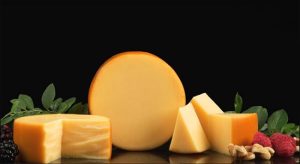Gouda Cheese:
Khavda cheese or Gouda cheese is almost hard and yellow cheese made from cow’s milk. This cheese was first made in the city of Hawda (Gouda) in the south of the Netherlands and is now known all over the world by the same name.
Gouda cheese was first added to their production line by Kalin and Kale factories in Iran and is available in small packages or in the form of 6 or 10 kg tablets.
The nutritional value of each kilo of Gouda cheese is equivalent to 15-20 kilos of fresh cow’s milk.
The reason for the high price of this cheese depends on 2 factors, the amount of milk used for each unit, and the time required to store and ripen the cheese.
Gouda is one of the oldest cheeses in the world, which has been mentioned since 1184 AD. This cheese is the same name of the city of Gouda in the Netherlands. This name has nothing to do with the place of origin or production of this cheese, but because it is traded in this city, it got such a name.
is one of the most famous cheeses in the world, which has gained many fans all over the world today with its mild and nutty aroma and pleasant taste. This cheese is rich in calcium, protein, phosphorus and various vitamins.
This cheese is used raw or cooked in pizza, lasagna, salad, cheeseburger, breakfast, soup, sauce and sweets.
Cheese storage time:
Dutch cheese producers have divided this cheese into 6 categories in terms of age.
· Fresh cheese (4 weeks)·
Freshly ripened cheese (8 to 10 weeks)·
Ripe cheese (16 to 18 weeks)·
Very ripe cheese (7 to 8 months)·
Aged cheese (10 to 12 months)·
Very old cheese (12 months or more)
How is Gouda made?
When the resulting milk curdles, some of the liquid whey is removed and replaced with warm water and then drained. This is known as “curd washing” and helps to remove excess lactose, thus preventing the formation of lactic acid. In the next step, the curds are pressed into round molds and poured into a salt water bath. Then the cheese is dried, covered with wax or plastic, and the aging process takes place from one month to more than a year.
Steps of making Gouda cheese:
In the preparation of Gouda cheese, after pasteurizing the milk, preparing and cutting the obtained curd, removing the whey and molding.The following steps are performed:·
Salting:
When the molded cheese reaches the required pH, which is determined by the yellowing of the cheese, it is immersed in a salt water solution. The salt is absorbed by the cheese. This slows down the growth of bacteria, helping the cheese taste better ·
Coating:
After removing the cheeses from the brine and drying them overnight, they are covered with “cheese coating” which is also considered a food item. The function of the coating is to protect the cheese from contamination, while still allowing moisture to evaporate. It also improves the appearance of the cheese. ·
Maturity:
coated cheeses are placed on the shelves of a room. The room is kept at a constant temperature of 16°C and humidity of 80%. This allows the cheeses to ripen to develop their characteristic flavor and texture. During this time, the cheeses lose their moisture and are turned daily to help create a consistent texture. ·
Packaging:
When the cheese reaches the required maturity, it is vacuum packed and placed in a cool warehouse at a temperature of 4 degrees Celsius. This slows down the ripening process so the cheese retains its flavor and also prevents contamination.

